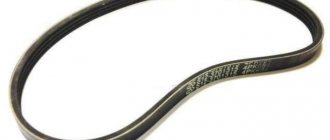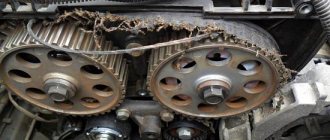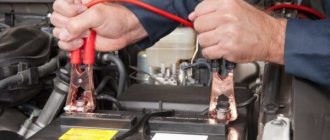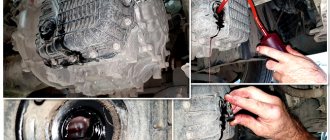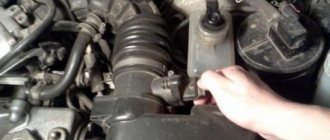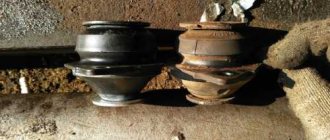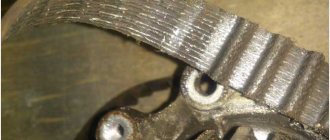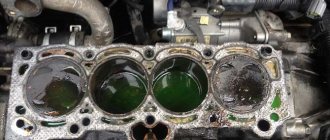26.10.2021
| (Votes: 1, Rating: 5) |
Issues discussed in the material:
- Purpose of the timing belt
- 6 main reasons why the timing belt breaks
- Signs of a broken timing belt
- Consequences of a broken timing belt
- Timing belt replacement interval
- Instructions on what to do if the timing belt breaks
- Reviews from car enthusiasts about timing belt failure
Why the timing belt breaks is a question that haunts many drivers. Replacing this unit is often expensive, and its wear can occur for a variety of different and often simply unknown reasons. Let's say right away: a breakdown usually represents a whole series of factors that were initially overlooked.
Let's tell you more about them. Read about the key points, signs and consequences of a broken belt. You will also find advice on what to do in the event of a breakdown and how often to change the unit. With this information, you will be better savvy and prevent your car from breaking down.
Purpose of the timing belt
The timing belt is an indispensable part of the power unit, ensuring synchronism and orderliness in the operation of the camshaft and crankshaft. Thanks to this element, each valve opens and closes when necessary.
A belt that is intact and unworn causes the camshaft to rotate at a set speed that is half that of the crankshaft. When the camshaft rotates, a fuel-air mixture (FA) enters the engine cylinders, and exhaust gases are discharged through a corresponding system.
The use of a belt became possible after the manufacturer asked the question of creating an engine with less weight and price. In addition, it was possible to significantly reduce the noise created during operation of the power unit. But all costs fell on the consumer. Changes associated with the advent of the timing belt have caused some difficulties during maintenance and replacement. The belt drive cannot last long, so on such engines it is necessary to constantly monitor its condition and tension.
When making changes, the designers expected that the timing belt would be close to the chain in strength, elasticity and wear resistance. After several attempts and experiments, the timing belt began to be made with three layers.
Toothed Pulley
There is another common mistake. To set the camshaft marks correctly, many people try to lock the toothed pulleys. There seems to be nothing wrong with this. BUT! If you stop with any metal objects, they may damage the teeth.
Minor scuffs or damage will appear. Which, when working, can literally eat a belt in a few thousand kilometers
Signs of a broken timing belt
Most often, a broken belt is accompanied by a bang and the engine stalls, while all other parts work normally. When you try to start the engine, you can hear a metallic knock, while the starter rotates easily because there is no compression in the cylinders. But you should not try to start the engine if you suspect a possible belt break. It's better to inspect everything carefully first.
The most severe consequences when restarting the engine are accompanied by a metallic knock somewhere in the engine area.
We use trusted manufacturers
The better the quality of the part, the longer it will work - this is a kind of axiom. Therefore, take only normal manufacturers, both the belt itself and everything else, rollers, pump and pulleys, if necessary (more on that below).
My advice is to go to an official dealer and buy everything from him. For what? Yes, you just need parts that are installed on the conveyor, so you will have a chance that they will work out the resource declared by the manufacturer.
Or look for famous brands, buy in trusted places (so as not to run into a fake). If you buy something of dubious quality, to put it mildly, then you shouldn’t expect it to work for years.
Consequences of a broken timing belt
Having answered the question why the timing belt constantly breaks, we can analyze the problems caused by this disease, namely:
- Damage resulting in valve deformation. When the crankshaft and camshaft begin to rotate asynchronously, the pistons collide with the valves. As a result, the mentioned parts are damaged, and a major overhaul of the engine becomes necessary. Otherwise, the motor will have to be thrown away.
- If the consequences turn out to be insignificant and the main units remain intact, the repair will only consist of replacing the belt and adjusting it.
We recommend
“Which timing belt is better: a review of the best manufacturers” More details
Let’s look at some points in more detail. The situation with a broken timing drive and its danger depends on the design of the engine and the conditions under which it failed:
- A broken timing belt causes the camshaft to stop, causing the valves to freeze and stop moving . But due to inertia, the rotation of the crankshaft continues, the pistons hit the open valves, and they bend. Some types of engines installed, for example, on VAZ 2111 cars, have special recesses on each of the 8 valves that prevent contact with them if the belt breaks. You won’t find similar manufacturing features in modern engines, as manufacturers strive for maximum power while maintaining a small volume.
- If a situation occurs when the timing belt breaks at idle speed of the engine, then only a pair of valves may be damaged . Also, at high crankshaft rotation speeds, the guide bushings can become deformed. Such consequences entail the need to overhaul the engine or replace the cylinder head.
- A broken timing belt on a diesel engine will lead to deformation of the valves, camshaft and its bearings, cylinder head, connecting rods and pushers . The reason lies in their design, which is characterized by the absence of free movement of the valves when the piston is at top dead center.
- On Japanese engines, a broken timing belt is accompanied by failure of all valves, breakage of bushings, pistons and cylinder heads . All this is typical at high speeds.
Incorrect tension
Next comes technical advice; the timing belt can often break due to improper tension. Again, take a 126 motor, it has a tension roller, it must be tightened in a certain position. It has two marks that need to be aligned.
Many overtighten, others don't tighten all the way. All this leads to incorrect operation, it will simply tear or fly off. So the tags were not invented in vain. In general, read the user instructions before replacing.
Timing belt replacement interval
Even in cases where the engine is running perfectly, do not forget about the need to monitor the condition of the timing belt, because it also does not last forever. The mileage after which the part needs to be replaced is indicated in the car’s technical passport. But you can do it differently: install a new belt every 50 thousand kilometers.
If you purchased a used car, and the seller did not provide any information about the installation date of the timing belt, then simply inspect it. The presence of microcracks on the body is a reason to think about it.
But don’t worry too much, since microcracks only tell you that the unit requires attention, but it is unlikely to break during the first start-up. Inside the belt there is a metal base made of thin rods. This ensures that it is able to withstand large starting loads and not break off for a long time.
There are cars that the manufacturer equips with impact-resistant belts with reinforced metal cords. Thanks to this approach, the service life increases by about a third.
First mistake - KIT - kit
Nowadays they don’t just buy one timing belt, they buy it immediately assembled, as a set. Usually there are two plus rollers (tensioner and guide), this is what is called KIT - translated as a kit.
BUT if you take, say, a 126 engine (PRIORS, KALINA, GRANTS, etc.), this is, to put it mildly, not quite the right replacement. After all, if you replace only the rollers and belt drive, you will still have the old pump. And if you have driven 120,000 km on it, it can easily and simply jam, and even after such a huge mileage it is no longer working, to put it mildly, quite correctly
So if the kit does not include a pump, but you have one going through the timing system, we will definitely buy it in addition.
After all, it is precisely because of it that the entire system often breaks and collapses.
Instructions on what to do if the timing belt breaks
If the timing belt breaks, the following order should be followed:
- Lift the hood and move aside (or remove completely) the cover protecting the mechanism.
- Next, you should carry out a visual inspection of the belt (the break point will immediately catch your eye). If the break occurs in the lower part, then in order to see it, you will have to turn the crankshaft half a turn.
- The next step is to move the car to a garage or service station by resorting to towing. If the car has an automatic transmission, you will have to call a tow truck, since towing such cars is strictly prohibited.
Crankshaft PULLEY wear
As it becomes clear, it is put on the crankshaft (crankshaft) and then rotates two large camshaft pulleys.
So, due to the fact that it rotates at very high speeds, it can actually wear out. According to technical literature, after 120,000 kilometers wear is 0.15 mm in diameter.
Because of this, it will begin to bite the belt teeth, which will lead to rapid wear, literally after 10,000 km
What to do? Yes, just replace it when replacing the entire timing system. Which is done extremely rarely, because dismantling it, simply removing it, is quite problematic. But it is often the reason for the frequent breakage of the belt drive
Belt Drive Condition Assessment
The average service life of a timing belt is 50-70 thousand km. The exact replacement intervals are indicated in the repair and operating manual for your car. In situations where, after purchasing a car, there is no reliable information about the timing of previous maintenance of the timing drive, the need for urgent replacement can be understood by the following signs:
- Cracks in the belt base.
- Wear of the upper edge of the teeth.
- Oil on the timing belt.
- Noise from the pump, tension or idler pulley.
- Worn belt edges.
What to pay attention to during the renovation process?
The success of the repair largely depends on the correct troubleshooting of the gas distribution mechanism parts and the cylinder-piston group. If the timing belt breaks, pay special attention to measuring the protrusion of the pistons and checking the geometry of the valves. Check the condition of the valve guides and the chamfers of the valve seats in the cylinder head. Requirements for serviceable valves:
- the diameter of the valve stem is the same along the entire length of the stem;
- plate runout no more than 0.025 mm;
- the beating of the rod over a length of 10 cm does not exceed 0.015 mm;
- The valve chamfer has no deep damage.
To check the runout of the rod and disc, the valve is mounted on a pair of V-shaped stops. The measurement is carried out with a dial indicator mounted on a special stand.
